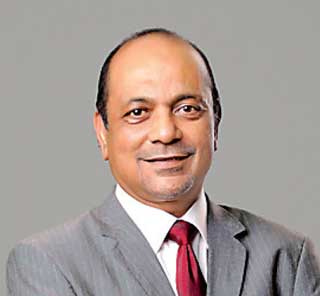Friday Dec 05, 2025
Friday Dec 05, 2025
Wednesday, 2 March 2022 00:10 - - {{hitsCtrl.values.hits}}
Bank of Ceylon has concluded 2021 with what it described as “unprecedented value creation” for all stakeholders with record lending and achievement of Rs. 43.2 billion in profit before tax.
 |
| Chairman Kanchana Ratwatte |
 |
| General Manager K.E.D. Sumanasiri
|
It said as the largest bank in the country the contribution of Bank of Ceylon in functionalising the initiatives taken by the Central Bank of Sri Lanka in stabilising the macroeconomic fundamentals of the country is commended universally.
“During this difficult situation, the bank of Ceylon stamped its class by continuing to play the role of being Bankers to the Nation and supported the nation to deliver its mandate of uplifting the COVID-19 hit economy. Availability of banking services was ensured even during lockdowns without compromising on the customer needs.
“The digital delivery channels were enhanced to cater to the unprecedented demand and the greater customer adoption rates to digital platforms. We continue to stand by our valued customers and our priority was assisting them in all possible ways in order to recover and support the country’s economy with more energy,” BOC Chairman Kanchana Ratwatte said.
“The bank tirelessly worked on ensuring that maximum benefits of the CBSL announced moratoria were being transferred to customers with least possible time lags. Going further the bank’s own concession schemes were also offered to customers.
“At the same time, more focus was given on uplifting the SME sector by way of continuous engagement and giving them the much-needed business acumen in addition to our role of financing. Moreover, as the largest bank in the country, the bank’s leading role in ensuring stable supply of essential import commodities such as fuel, food, vaccines, medical supplies is also noteworthy,” Ratwatte added.
Speaking on the BOC’s performance in 2021, General Manager/CEO K.E.D. Sumanasiri said: “The bank was able to reiterate its position as the undisputed market leader in Sri Lanka’s banking sector, demonstrating its unparalleled ability to truly support its customers and the overall economy in trying times.”
Demonstrating its strength, agility and strategic approach in succeeding in the midst of challenges, the bank was able to show a notable increase in both its fund-based and fee-based income during the year and recorded Rs. 43.2 billion Profit Before Tax, regardless of headwinds created by market interest rates fluctuations and stressed portfolio quality emanating from COVID-19 related economic impacts.
This is a remarkable achievement for the bank as it denotes the bank’s strength of converting challenges into opportunities. “Further, the bank’s asset book surpassed Rs. 3 trillion during the year surpassing another milestone in our journey,” Sumanasiri added.
Following are highlights of the BOC’s performance in 2021.
Fund-based income
Mostly, owing to loan growth and continuous credit monitoring efforts put in place during 2021, the bank reported Rs. 260.5 billion interest income which is a 15% increase over the year 2020. The benefits of the remarkable loan growth achieved in the previous year materialised during this year, generating an interest income of Rs. 193.1 billion through loans and advances which is 74% of the total interest income.
The main contributive portfolios were overdraft, term loans and personal loans. The Debt instruments which mainly comprises Government Treasury Bills, Bonds and other Foreign Currency Sovereign Bonds brought the major portion of interest income earned from the investment portfolio which stood at Rs. 65.7 billion.
In the meantime, interest expenses declined by 2% to Rs. 149.3 billion in line with the improvement in the CASA ratio to 36% from 35% (2020) and repricing the deposits at lower rates. The inverse movement in interest income and interest expense positively contributed to Net Interest Income (NII) of the bank and NII increased by 49% to Rs. 111.3 billion YoY.
Non-fund-based income
Non-fund-based income of the bank grew by 42% YoY basis and the main contributors were fee and commission income and exchange income. Fee and Commission income has shown a sizable growth owing to a flourishing trend reported towards digital banking channels.
Suitably, transactional banking related fee and commission income has formed a major portion of fee and commission income reporting 69% of the fee and commission income. During the period under review, an exchange gain of Rs. 9.2 billion was also reported.
Impairment charges for loans and advances and other financial instruments
Impairment charges for loans and advances for the period amounted to Rs. 35.4 billion bringing the loan to impairment provision reserve ratio to 6%. NPA ratio stood at 4.5% against 4.8% reported by end 2020.
Nevertheless, in calculating the impairment charge, the bank always follows a prudential approach; given the high degree of uncertainty and extraordinary circumstances in the short-term economic conditions mainly caused by the continuous disruptions to businesses. The bank made an additional expected loss provision using management overlays on identified risk elevated industries.
Individually significant customers were thoroughly assessed for their repayment capacity irrespective of the moratorium or concessions they enjoyed due to the COVID-19 situation and necessary provisions were made along with the independent review. Consequently, the provision made for stage III customers escalated by Rs.19.7 billion (19%) and provision for Stage II customers increased by Rs.3.7 billion (32%).
The bank has considerable exposure to investments in foreign currency denominated sovereign instruments by way of Sri Lanka Development Bonds and International Sovereign Bonds. As per the regulatory and Accounting Standards requirements a significant amount of provision amounting to Rs. 8.3 billion was made for investments in aforesaid instruments accounting the impact of sovereign downgrade.
Operating expenses
The operating expenses of Rs. 41.7 billion consists of personnel costs, assets maintenance, deposit insurance and other overhead expenses. The increment of 26% by Rs. 8.6 billion reported in operating expenses in line with the increase in personnel expenses due to the revision of salary scales according to the collective agreement, absorption of Trainee Staff Assistants to the permanent cadre and provision made for post-retirement benefit plans.
Other expenses settled at Rs. 12.6 billion for the year with a 18% upward, backed by an increase in deposit insurance premium due to growth in deposit base, upturn in office administration and establishment expenses which includes special transport arrangements for staff and expenses made in relation to COVID-19 related special safety measures at the bank’s premises.
However, the bank’s cost to income ratio of 32% shows prudent and effective cost management mechanisms adopted by the management to maintain the cost escalation in line with revenue growth.
Tax expenses
VAT on financial services which is charged based on the value addition made by the financial services has a direct relationship to the growth in PBT. That being the case, the growth of 80% reported in operating profits, the VAT on financial services also increased to Rs.9.0 billion with the 65% YoY growth.
Although the income tax expenses reported in the Income statement is Rs. 5.6 billion after the adjustments made for deferred tax, the total income tax payment which will be paid for the year of assessment accounts to Rs. 10.3 billion.
Loans and advances
During the period the bank’s total assets grew by 27% and reached Rs. 3.8 trillion, preserving its industry leadership. The key contributary factor is growth in loans and the investment book which denotes about 93% of the assets of the bank. The bank’s gross loan book surpassed the Rs. 2.0 trillion mark during the year 2020 and now stands at Rs. 2.6 trillion reporting a 22% growth during the period under concern mainly backed by growth in overdrafts, term loans and personal loans.
The lending to the private sector grew by 9% during the year and the bank continued to extend its support towards business revival. Focusing more on maintaining the portfolio quality and with a view to addressing non-performing facilities being transferred to hardcore facilities, the bank setup a Business Revival unit. The bank maintains adequate coverage for the expected losses and the provision reserve built so far covers the 6% of the total loan book for expected losses.
Deposit base
The bank’s deposit base during the year has increased to Rs. 2.9 trillion with a 16% YoY growth and 77% of the Deposit base comprises local currency deposits. The Balance 21% which denotes foreign currency deposits stood at Rs. 613.2 billion as of end 2021. BOC is the market leader in foreign currency remittances and during this year the foreign currency deposit base grew by 10%. Current and Saving deposit (CASA) base which generates funds at low cost represents 36%.
Key performance indicators
Return on Assets (ROA) ratio of the bank stood at 1.3% while reporting a 21.0% Return on Equity ratio. Both these ratios improved from the previous year attributable to the increase in profit.
The key regulatory ratio of the banking industry; Capital Adequacy Ratio (CAR) was maintained well above the regulatory norms and the bank always strives to maintain adequate buffers on all its regulatory norms to absorb unforeseen risk factors.
The Tier I Capital and Total Capital ratio stood at 13.1% and 16.8% respectively as of end December 2021, both of which were above the regulatory norms. Despite cash flow deferments in loan instalments, the bank was able to maintain a better trade -off between the liquid assets and its liabilities. All liquidity ratios were maintained in the safe zone.